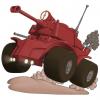During my Long egress from this site, I have met and befriended an aspiring coder at my school who has experience with unity, and have met a teacher and another student who both have experience with the engine (one is a new graphic designer).
In addition, I have logged onto the unity forums and have gotten some encouraging advice from some of the posters there, and I plan to create my first game using that engine. Finally, i have conceptualized two new games, both of which are indies (one is larger than the other though).
There are two things I'd like to mention on this post:
- TWO NEW GAMES:
These two games are both RPGs. I will also provide a list of sample critique points for you to fill in if you feel the need.
FRITE FUZERZ (Eastern-style Turn-based narrative RPG): demented, infested with potty and gallows humor, and obsessed with moral panics when it is being serious, Frite Fuzerz is a burtonesque RPG inspired by the likes of Goosebumps crossed with a children's anime of the late 1990's, such as Digimon. There are few words that can describe this RPG other than demented, insanely funny, crazy, and most importantly, unique. The game is a Turn-based RPG with heavy tactical elements, such as character positioning (used for attacks, as they do not auto-target). The battle system is also unique in the way that it does not transition into another screen when combat begins; instead, it goes from real-time exploration to turn-based combat within the same environment. Dungeons are explored using a series of fixed viewpoints similar to security cameras that can be rotated between, and there is a radar for ease of exploration (monsters cannot be seen on the radar; the player must instead find clues within the level to determine where an enemy is). Another unique mechanic is the presence of monster-transformation; the main characters can use soul pacts to turn themselves into monsters to fight. Story-wise, the game is heavily based around the satanic panic of the late 1990's (and the lives ruined, innocents demonized and railroaded, and tragedies of the hysteria) and how humans would actually react to the existence of supernatural creatures, especially when religion is concerned. The game is for the PC, and is targeted towards kids.
- critique points:
- is it appropriate for kids? (due to the heavier themes of society and fear, do any of you believe that this game could effectively be marketed to that audience).
- Battle system (will forcing all movements to be turn based be easier to code than transitioning to another screen?)
- Dungeon exploration (I have had a supposition that rotational fixed views would be inflexible and difficult to control, what about you?)
SOMNION: DARKEST DREAMS (Western-style sandbox/dungeon crawl RPG with visual novel elements): Lovecraft has never been more tween! Somnion: Darkest Dreams is a Sandbox RPG/Dungeon-crawler hybrid that uses a combination of atmosphere and randomization to set the gameplay and experience. Gameplay-wise the game uses a much-less-difficult variation of Bloodborne's combat system (with added options for ranged attacks) combined with a TES-like quest system and a unique item and equipment customization system based off of patterns. Atmospherically (as can be inferred by the title, Somnion partially takes place in a dream world), the game uses a combination of anachronistic technology, nightmarish dreamscapes, an ambiguous lore and mysterious world, and extensive randomization to paint an unsettling picture for the player. All this, however, only occurs while the player character is asleep. While awake, they live mostly ordinary lives, befriending and spending time with other non-playable characters and doing other activities while investigating a mysterious conspiracy perpetrated by fellow students of their middle-school. What happens it the dream world can affect the waking world, and vice-versa. The player may gain access to allies in the dream world by befriending and having relationships with NPCs and can perform actions (such as completing quests or defeating monsters) in the dream world that may aid characters in the waking world. The story also relies on randomization, though these are limited to only a few major and minor points, aside from characters. The game is aimed at the 12-14 age group, and is going to be a download title on both PC and major consoles at about 20.00 USD.
- Critique points:
- Is this AAA/will it require a publisher? (I conceptualized this game with the estimation of an around 100K USD budget. Will it require more?)
- Is it appropriate for the specified age group? (despite Somnion's visceral combat, there is no gore as monsters and dreamselves bleed black or white energy. In addition, the game incorporates psychological horror elements and while not a true cosmic horror story on account of the fact that the resident eldritch abominations are mortal and can be killed, Somnion does take heavy inspiration from HP Lovecraft.)
- Randomized story: a good idea? (despite the fact that only a few aspects of the story can be randomized, and that those, like items and characters, are based off of patterns).
- My potential first game:
Some of the advice I got from the Unity forums recommended that after my "team" (me, my friend, his 4 friends, my teacher, and my teacher's friend) completes all of the official tutorials is the time when I should be conceptualizing my own games. Despite this I'm having some trouble communicating with all the members of my team, so I've taken to designing a simple dungeon-crawler.
It has two levels, five weapon and enemy types, one boss at the end, and is made using pre-made assets and is turn based.
- questions:
- Any of you know a good way of networking a small team like the one I just mentioned? could I use Gmail or some other form of email
? - How long will it take to complete all the tutorials, and then the dungeon crawler? how much will it cost? any estimates?







